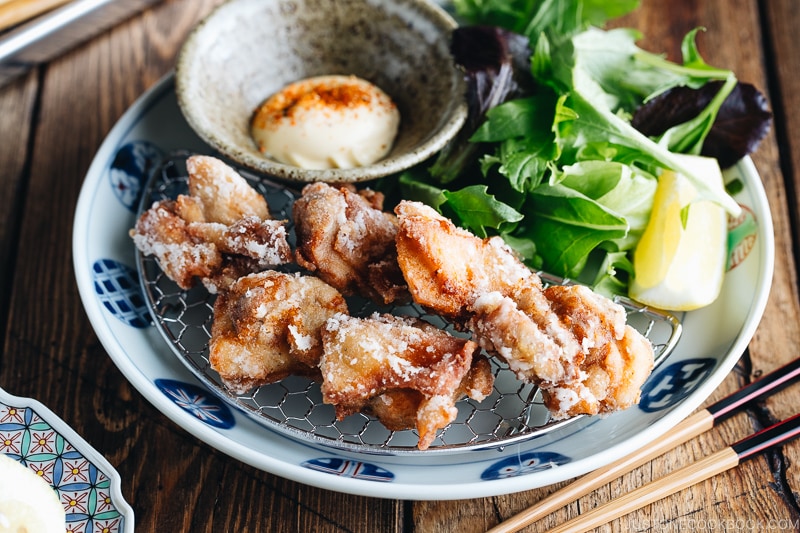
Karaage (Japanese fried chicken) is easily one of the greatest fried chickens in the world. It’s exceptionally flavorful, juicy and ultra crispy, and absolutely worth hanging out at the stove for! Learn the simple techniques and fry up some glorious chicken at home today.
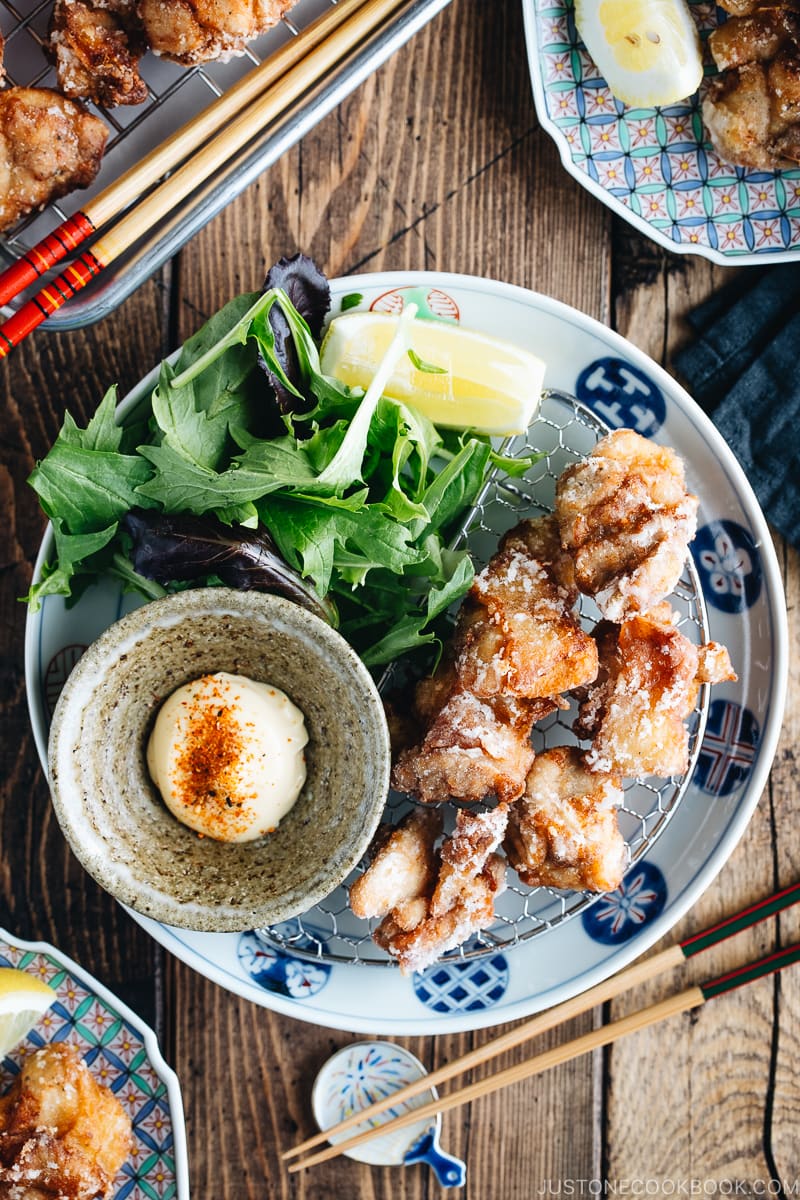
Karaage (唐揚げ), or Japanese fried chicken, is a classic dish you can find at any Japanese home, bento lunch box, street-side stalls, restaurants, or diners. Come in bite-size nuggets, anyone who has tried the fried chicken can tell you how deliciously addicting it can be.
I grew up eating a countless number of karaage, and mom’s version was always the best. Just like any Japanese home cook in her generation, mom never shied away from deep frying, especially when comes to a dish worthy to make for the family. The chicken always turned out with cracker-crisp skin and the meat absolutely something you want to gnaw with great abandon. Thanks to mom, I’m able to share the fried chicken love with you. And I promise: it’s going to be really good!
How to Make Karaage (Japanese Fried Chicken)
Karaage (Japanese fried chicken) is easily one of the greatest fried chickens in the world. It’s exceptionally flavorful, juicy and ultra crispy, and absolutely worth hanging out at the stove for!
What is Karaage?
Pronounced as ‘ka-RA-AH-geh’, the word Karaage implies the food and technique of which an ingredient is lightly coated with flour and deep-fried. When you hear “karaage”, most of us assume it’s chicken karaage, but it can also be fish or vegetables.
For chicken karaage, it’s essentially bite-size chicken thigh dusted with flour and deep-fried in hot oil. With tender and juicy marinated chicken coated in a crispy shell, Karaage is a staple in Japanese home-cooked meals.
You may find this delicious Japanese fried chicken being served at:
- home – it can be a main dish or appetizer.
- diner and restaurant – karaage teishoku is a popular set meal.
- Izakaya and bar – served as an appetizer to go with a drink.
- supermarket, convenience store, and depachika (B1F – the gourmet food galore in the basement of a department store).
- bento shop – karaage bento is a popular choice
Karaage vs. Tatsutaage
Some of you may know there is a dish that is very similar to Karaage. Known as Tatsutaage (竜田揚げ), the chicken is marinated in soy sauce and mirin, coated with potato starch (katakuriko), and then deep-fried till golden brown.
Wait, isn’t it almost identical to Karaage?
As mentioned earlier, Karaage originally implies that the ingredient was simply coated with flour and then deep-fried, and there was no marinating involved. However, in recent years, the Japanese use these terms interchangeably. Karaage has more variations when comes to seasonings and a lot more flexibility in how it’s being prepared, while Tatsutaage has a signature method to go by.
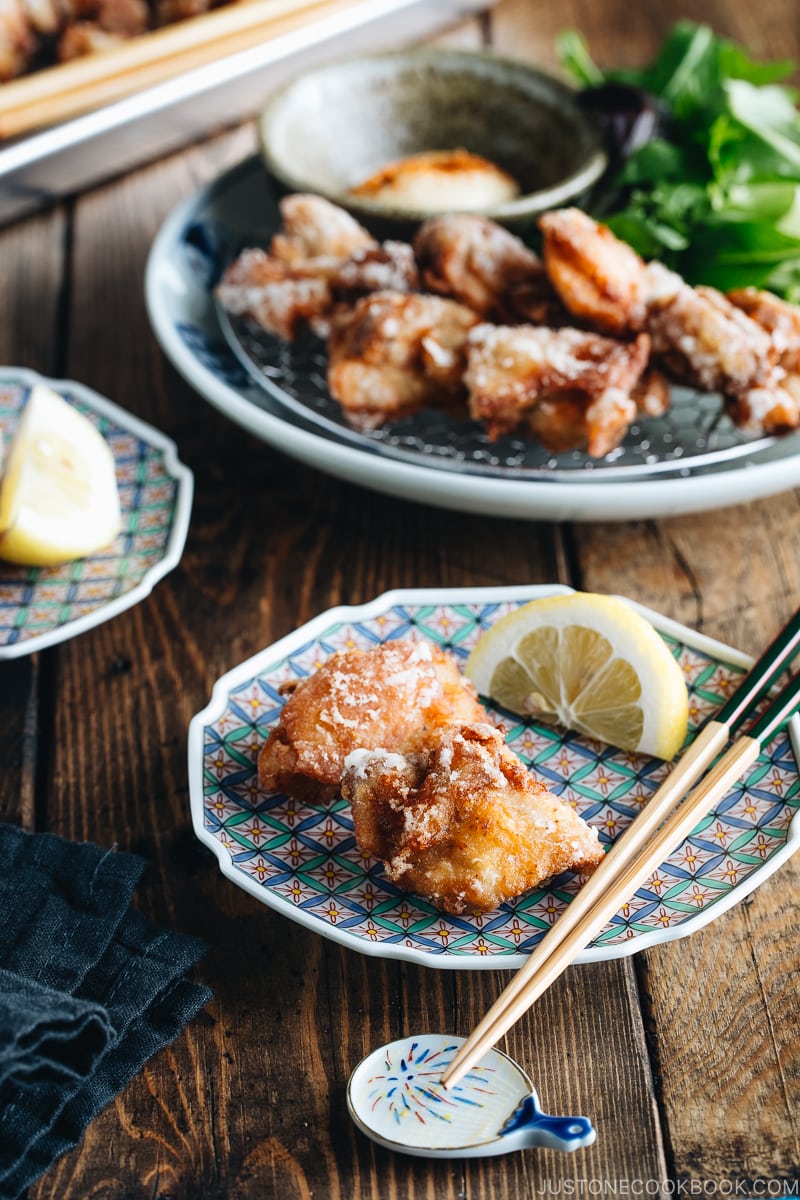
4 Key Ingredients for Karaage
1. Chicken
In Japan, Karaage is typically made with skin-on boneless chicken thighs, which has more flavor than chicken breasts. However, if you really want to use breasts, that’s okay.
Here in the US, skin-on chicken thighs are always sold with bones. To save time, I usually ask my friendly butcher to remove the bones for me. Why do we need to use skin-on? The skin keeps the karaage crispy on the outside and the meat juicy inside.
2. Marinade/Seasonings
There are so many variations of marinade/seasonings available for Karaage, and this is really up to you. I make mine slightly different all the time. However, the primary base should always include soy sauce, sake, and ginger.
Sake helps tenderize the meat while ginger gives zing and removes the gamey taste.
Some variations for the seasonings include:
- garlic
- sesame oil
- mirin
- oyster sauce
- curry powder
- egg yolk (See my other karaage recipe)
- Japanese mayonnaise (I haven’t tried it…)
Feel free to experiment with the ingredients and see what you like!
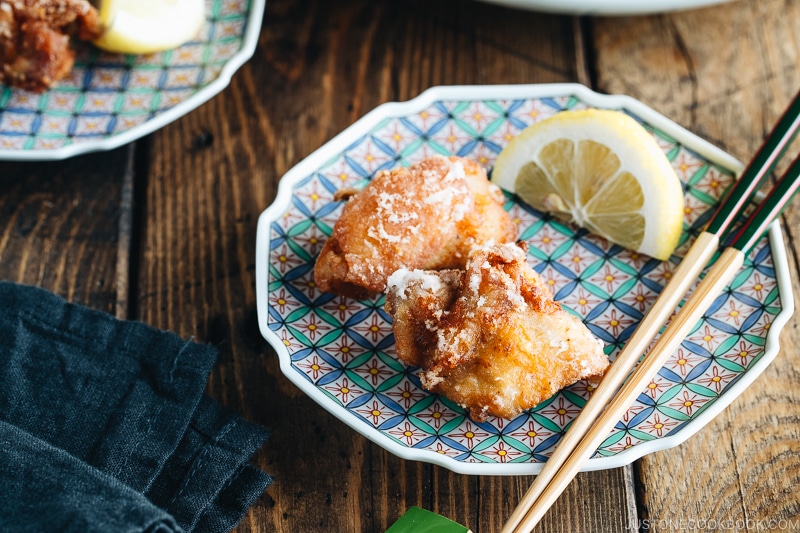
3. Coating
This is another flexibility you can work with by testing out different ratios:
- Flour – you can decide cake flour (lighter shell) or all-purpose flour (easily available in the US)
- Potato starch
- Flour + potato starch
- Rice flour + potato starch (see this recipe) – this is gluten-free!
In this recipe, I use equal parts of all-purpose flour and potato starch. I first dredge the chicken in flour and then potato starch. The flour will trap the marinade and seasonings inside the shell, and potato starch will create a crisp texture on the outside. You can premix the flour and starch, but I actually like dredging in 2 stages for the best result!
Potato starch vs. Corn starch
In Japan, potato starch (or katakuriko 片栗粉) is most commonly used as a coating for frying foods. Here in the US, corn starch is much easier to access in regular grocery stores, so that is a close substitute if you have trouble finding potato starch.
As a comparison, I found that karaage made with potato starch yields a crispier skin and texture. If you compare these two starches by rubbing them between your fingertips, you will notice the difference.
Potato starch is available on Amazon and larger grocery stores. I think it’s worth looking for it to make delicious Karaage.
Are potato starch and potato flour the same?
No, they are not the same. Potato starch is made from the dried starch component of peeled potatoes while potato flour is made from whole (raw or cooked) potatoes being dried then ground into flour.
4. Deep-Frying Oil
My recommendation for deep frying oil includes:
- Canola oil (キャノーラ油)
- Safflower oil (べに花油)
- Rice bran oil (米油)
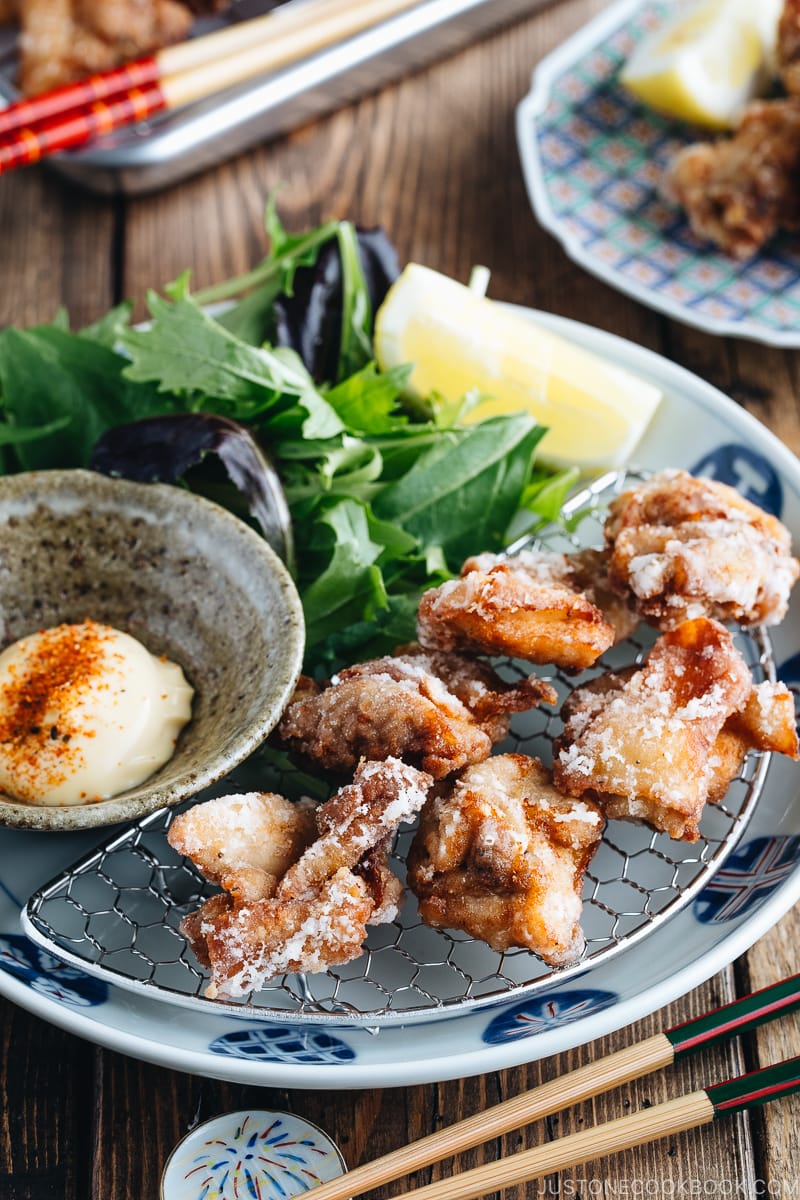
4 Helpful Tips to Remember
- Cut the chicken into same size pieces – It’s very important that each chicken is similar in sizes so you can cook evenly.
- Don’t marinate too long! – 30 minutes is ideal for the chicken to soak in the flavors.
- Lightly coat the chicken. – Remove the excess flour. It will make the oil cloudy and doesn’t give a good texture to the chicken.
- Double fry! – Fry at a lower temperature first, let it cook with remaining heat, and lastly make it crisp at the higher temperature.
Because they are bite-size, Karaage is utterly doable at home. It may require some extra oil, but you know you would be dishing out some glorious fried chicken at home!
Craving for more fried chicken recipes?

Japanese Ingredient Substitution: If you want to look for substitutes for Japanese condiments and ingredients, click here.
Sign up for the free Just One Cookbook newsletter delivered to your inbox! And stay in touch with me on Facebook, Pinterest, YouTube, and Instagram for all the latest updates.
Karaage (Japanese Fried Chicken)
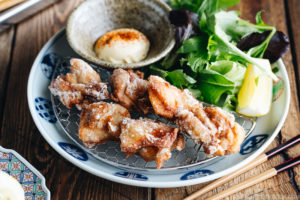
Let's make Karaage (Japanese fried chicken), one of the greatest fried chickens in the world! It’s exceptionally flavorful, juicy and ultra crispy.
- 1.5 lb boneless skin-on chicken thighs ((680 g or 4-6 pieces; Read the blog post))
- ½ salt (kosher or sea salt; use half if using table salt)
- Freshly ground black pepper
- 2 Tbsp potato starch/cornstarch ((Add more if necessary; Read blog post))
- 2 Tbsp all-purpose flour ((Add more if necessary))
- neutral flavor oil (vegetable, canola, etc) ((for deep frying))
Seasonings:
- 1 knob ginger ((You'll only need ½ tsp grated ginger))
- 1 clove garlic
- ½ Tbsp soy sauce
- ½ Tbsp sake ((Sub: dry sherry or Chinese rice wine or skip))
- ½ tsp sesame oil (roasted)
Garnish (optional)
- Lemon ((for taste and garnish))
- Japanese mayonnaise ((optional for dipping))
- Shichimi Togarashi (Japanese seven spice) ((optional for spicy taste))
-
Gather all the ingredients.

-
Cut each chicken thigh into 2-inch pieces and season with salt and freshly ground black pepper.

-
Grate the ginger (you will only need ½ tsp) and mince the garlic (I use a garlic presser).

-
In a large bowl, combine ginger, garlic, ½ Tbsp soy sauce, ½ Tbsp sake, and ½ tsp sesame oil. Whisk all together.

-
Add the chicken to the bowl and mix with your hands. Cover and keep in the refrigerator to marinate for 30 minutes.

-
Pour the oil to a heavy-bottomed pot (I used a Dutch oven) and heat the oil to 325 ºF (163 ºC) on medium heat.

-
Meanwhile, prepare potato starch and all-purpose flour in a separate pile.

-
First, lightly dredge each chicken piece in the flour and dust off the excess flour. Then dredge the chicken in the potato starch and remove excess starch.

-
Continue with the remaining chicken.

-
When the oil temperature has reached 325 ºF (163 ºC), gently submerge each chicken piece into the oil. Do not overcrowd; add 3-5 pieces at a time. If you put many pieces in the oil, the oil temperature will drop quickly and chicken will end up absorbing too much oil.

-
First Deep Frying: Deep fry for 90 seconds, or until the outside of the chicken is a light golden color. If the chicken changes color too quickly, then the oil temperature is too high. Either put a few more pieces of chicken in the oil or lower the heat. Controlling oil temperature at all times is very important for deep frying. Transfer to a wire rack to drain excess oil.

-
The chicken will continue to cook with the remaining heat on the wire rack. Continue with the remaining chicken. Between batches, pick up crumbs in the oil with a fine-mesh sieve. This keeps the oil clean and prevents it from becoming darker.

-
2nd Deep Frying: Now heat the oil to 350 ºF (177 ºC). Deep fry for 45 seconds, or until the skin is nice golden color and crispy. Transfer to a wire rack to drain excess oil and continue with the remaining chicken.

-
Chicken on the left is after the 1st frying and one on the right is after the 2nd frying. You can see the chicken is slightly darker in color.

To Serve
-
Serve the chicken hot. Karaage is often served with a wedge of lemon and Japanese mayo (sprinkle Shichimi Togarashi for a bit of spice).

Recipe by Namiko Chen of Just One Cookbook. All images and content on this site are copyright protected. Please do not use my images without my permission. If you’d like to share this recipe on your site, please re-write the recipe in your own words and link to this post as the original source. Thank you.
Editor’s Note: This post was originally published on October 10, 2012. The new video is added and the images have been updated in October 2019.
Resource : https://ift.tt/2vMxpFu



No comments:
Post a Comment